Tomatoes have leaves curling: why this happens and what to do
Perhaps, almost every gardener who has grown tomatoes at least once faced this problem, but this especially causes excitement among novice summer residents. Indeed, sometimes such a defect does not have any effect on yield at all, but in some cases it is quite a serious cause for concern. Therefore, you should know what causes can cause leaf curling in tomatoes.
So, next we will figure out why the leaves of tomatoes can curl, what affects this and how to help the plant to bounce back.

Content
The main reasons why tomato leaves can curl
In short, then In most cases rolling leaves is the normal reaction of tomatoes to unfavorable growing conditions. However, in some (rare) cases, this is evidence of plant damage by pests (for example, aphids or whiteflies) or a dangerous viral disease (yellow curly leaves).
Thus, the reasons can be very different. First of all, you need to look at the nature of leaf rolling + growing conditions and try to establish the true cause, and depending on this, take some measures.
Note! The twisting of the cotyledon (fake) leaves, which always occurs in the process of growing tomato seedlings (especially after planting in the ground), is an absolutely normal, or rather, a natural process of their withering away. It's another matter if deformation occurs with real leaves, which we will talk about later.
Curling of leaves in tomatoes due to care errors or unfavorable weather conditions (not dangerous)
Watering and moisture
The main reason rolling leaves in tomatoes is improper watering, namely his disadvantage... because of lack of moisture the plant is forced to twist its leaves to reduce the evaporation of moisture from their surface... However, the leaves can acquire darker shade.

Therefore, tomatoes are needed water on timerather than waiting for his signals.
Advice! There is a detailed article on our website about how to properly water tomatoes in the open field and in the greenhouse.
Alternatively, to avoid watering the tomatoes as often, you can mulch the soil under the bushes (for example, peat) so that the mulch does not allow moisture to evaporate quickly.
Interesting! Sometimes the leaves of tomatoes can curl, on the contrary, due to waterlogging.
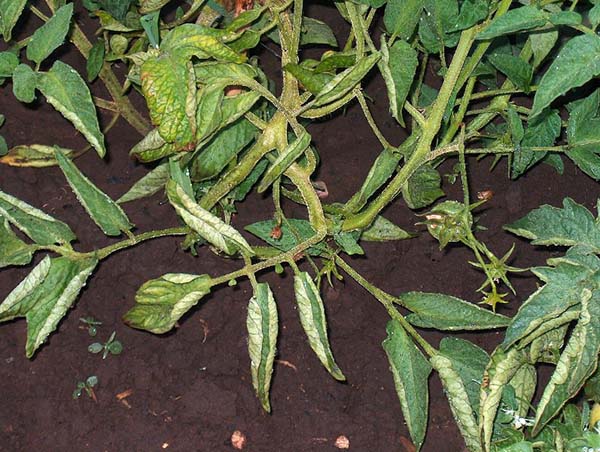
Actually, in the case hot and dry air = low humidity, as well as insufficient watering, curling of leaves will be an inevitable reaction of the plant to a lack of moisture.
This is especially true when growing tomatoes in a greenhouse. In other words, don't forget to ventilate their greenhouses.
Excess sunlight
Let's say that you grow your tomatoes outdoors. You have a sunny area (this is exactly what is required), but now the July heat has come, the sun is roasting ... and the tomatoes react accordingly, namely, they reduce the evaporation area and roll their leaves like a boat. In this case, the lower leaves, which are not so much illuminated, as a rule, look quite normal.
Actually, the fruits themselves (tomatoes) can get sunburn.

What can be done in this situation? Somehow shade your plants, for example, cover with gauze or white spunbond.
Sharp fluctuations in night and day temperatures
Tomato can react in a similar way to a sharp drop in temperatures, mainly at night, even if the temperature is relatively stable during the day.
Advice! According to some gardeners, the use potash fertilizers (and especially potassium humate) will be help smooth out negative growing conditions (natural disasters).
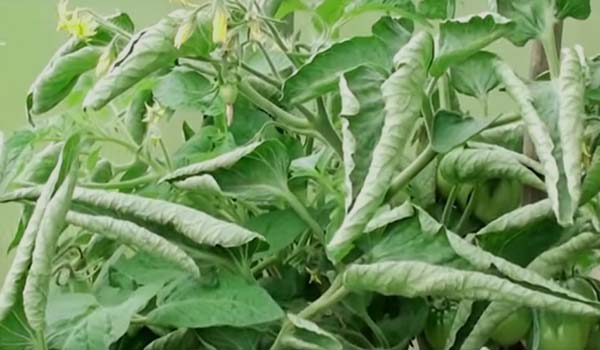
Important! High humidity, changes in night and day temperatures in the greenhouse can provoke the development of a disease such as brown spot of tomatoes (about this fungal disease, as the cause of leaf curling, read below).
Predisposition (feature) of the variety
There are varieties (and hybrids) of tomatoes that are corny more prone to curling. In other words, some varieties do not react in any way to unfavorable weather conditions, while others twist the leaves.
There is also an opinion that it could be related to the number of fruits (yield), in other words, the more fruits there are, the greater the lack of something (water, trace elements).Actually, this is quite logical: if the variety is fruitful, in order for it to bear fruit well, it needs a lot of nutrition.
By the way! Very often the leaves are curled in cherry tomatoes.

Lack or excess nutrition
If you adjusted the watering and humidity, the temperature conditions returned to normal, but the leaves did not stop curling, then something else is the matter. For example, in lack of certain macro- or micronutrients.
So, a plant can react differently to the absence of each of the main nutrients:
- with a shortage potassium the leaf can curl tips only (they also say what's going on marginal burn).
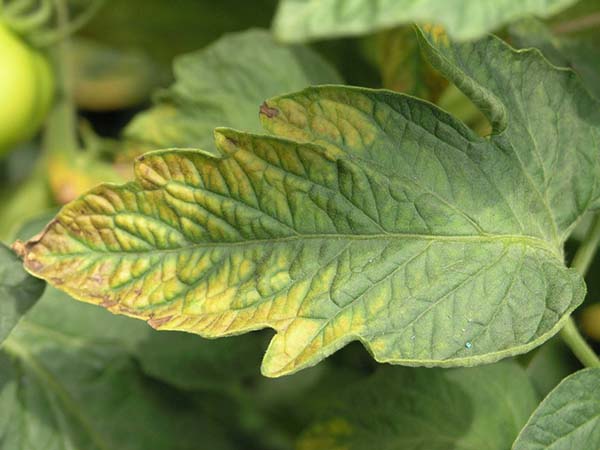
- if lacks phosphorus, then the sheet acquires purple tint and can curl.
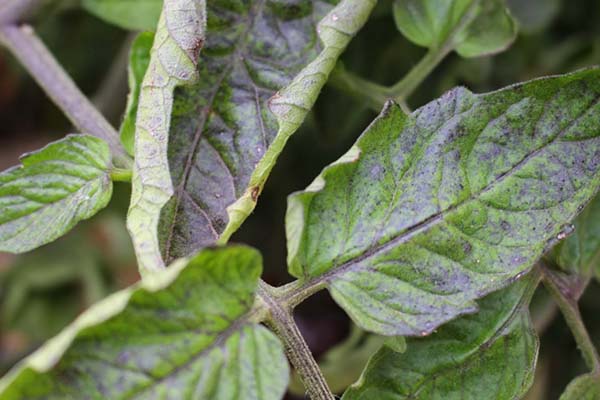
- if not enough zinc, leaves become very fragile and rough (rough) and can also curl downward, and orange-brown chlorosis forms on old leaves.
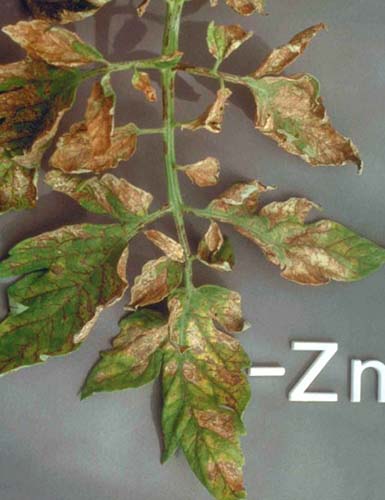
- if not enough borathen leaves brighten and again curl.
- with a lack copper and sulfur, young leaves usually wilt, and then may acquire a bluish-green color and curl upward (into a tube).
- disadvantage calcium manifested in the fact that the leaves veins turn white, and they themselves curl up.
- with a shortage gland - leaves turn yellow and sag, while also sometimes twisting.
- disadvantage magnesium.
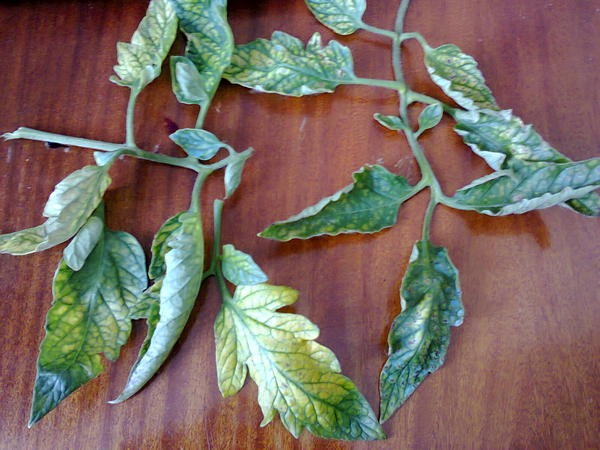
In this case, you need to spend top dressing with a certain macrofertilizer (potassium, for example, potassium sulfate or phosphoric, eg, superphosphate) or complex microfertilizer, for example, Gumat +7 or similar.
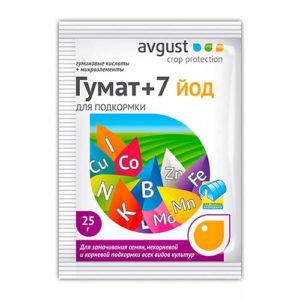
Nitrogen overdose
The opposite situation - you could simply overfeed their tomatoes nitrogen fertilizers... The plant began to fatten, a powerful and thick stem formed, and the leaves curled (the top has become curly).
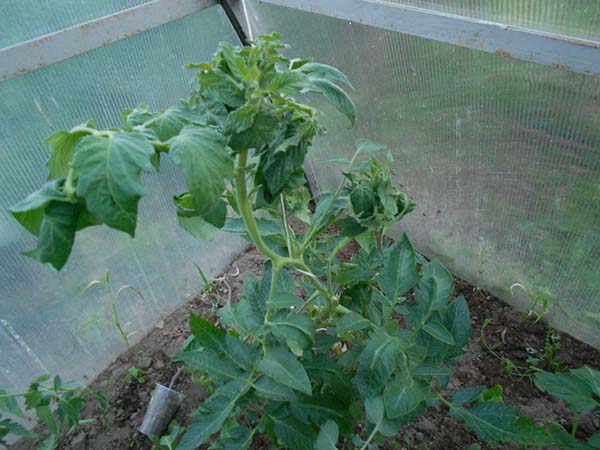
You have no choice but to try flush nitrogen from soil, namely spill plenty of water (suitable only for those who have sandy or sandy loam soil), but overflow is also harmful (especially if the soil is clay).
However, it will be much more effective make potassium dressing (potassium balances nitrogen, stops its absorption by the plant), and even better, carry out foliar dressing (spraying) on the leaves... For example, you can take potassium sulfate (10-15 grams per 10 liters) or wood ash (100 grams per 10 liters of water).
Important! Phosphorus can also balance soil nitrogen, which means you need superphosphate or other phosphorus fertilizer.
Untimely pinching
Another cause of tomato leaf curling can be to remove too many stepchildren and lower leaves in one go. Because of this, the plant begins to experience severe stress, which results in a similar reaction.
Thus, in order not to expose your tomatoes to unnecessary stress, the procedure for pinching and forming bushes must be carried out in a timely manner and according to the rules.
Video: correct pinching of tomatoes
Chemical damage
Ignoring the rules of use and dosage system herbicides (weed killers) can cause the leaves to curl upward or downward into a bowl-like shape.

Leaf curling in tomatoes due to pests and diseases (dangerous)
Pest attack
Leaf curling can be caused by a petty and nasty pest such as aphid.
When aphids settle on your bushes, sucking the juices, it simultaneously introduces a special substance into the plant, which causes curling of the leaves, as well as deformation of the stem.
Actually, when you make sure that it is just aphids (after carefully examining the leaves and finding insects), you need to immediately very carefully (all the sinuses) spray the bushes with insecticidal preparations (Fitoverm, Iskra, Hyphen Profi, Aktara, etc.).
It is possible that you confused aphids with whitefly... Or that spider mite... All these pests also suck out the juice and weaken the plant, causing curly leaves and transferring dangerous fungal (treatable), bacterial and viral diseases (the last 2 are not treated).

Fungal disease
Due to excessively high air humidity (above 80-85%) and lack of ventilation in the greenhouse, tomatoes may appear brown spot (cladosporium).
Signs of this fungal disease: on the leaves during the flowering period, pale yellowish (rather white than yellow) spots are formed on the upper side, and a light bloom of mycelium on the lower side. Gradually, the spots turn dark brown, velvety, and then affected leaves dry out, curl up and fall off.
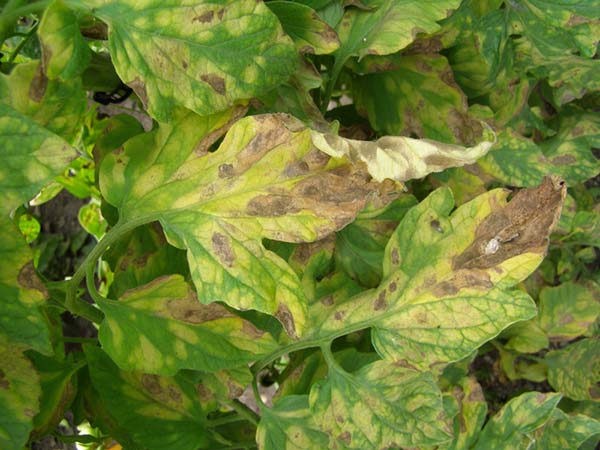
And fruits without leaves, naturally, do not develop.
To prevent this disease, you should systematically ventilate the greenhouse, as well as to exclude sudden changes in night and day temperatures.
Plus, to improve air circulation you need trim the bottom leaves, including amazedthat must be burned.
And if, nevertheless, you find the first signs of the disease, then immediately start spraying the plants with a solution of copper oxychloride (40 g per 10 liters of water, once every 10-14 days) or with a biological preparation Fitosporin (according to instructions) or Trichoderma Veride (Trichodermin).
Leaf roll virus (yellow curl in tomatoes)
The worst thing that can happen to your tomato bushes is the tomato yellow curl virus (TYLCV).
By the way! As a rule, gardeners in the southern regions most often face this problem.
Plants affected at an early stage of the growing season can be stunted (begin to lag behind in growth and development), with erect branches and with small chlorotic leaves that take a cup-shaped shape and curl upward. On severely affected plants, fruits are usually not set. Although in a less severe form, symptoms such as yellowing of the leaves of the compound leaf, the cupped shape of the leaves, inability to set fruit and underdevelopment of flowers can also often be observed when plants are infected at a later stage of the growing season. Fruits that are set before the plants become infected often develop normally.
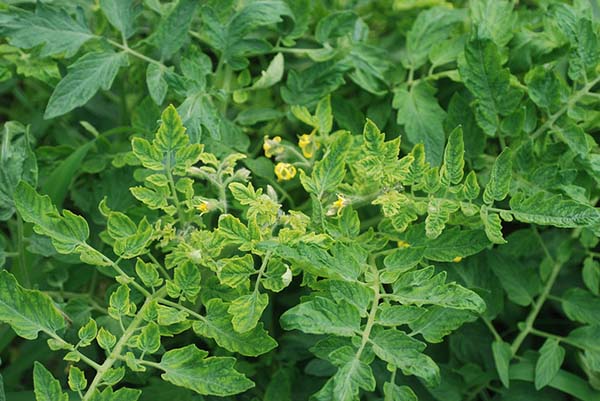
The carrier of the causative agent of the disease is the whitefly.
A favorable condition for the development and progression of the virus is a temperature above +25 degrees.
If you see a similar picture in your area, then such bushes need to be removed together with the roots and burned as soon as possible (although you can try to simply break off the shoots with affected leaves). You also need to treat the soil where the infected plant was located (for example, with Farmayod).
Remember! Viral diseases are not cured.
Bacterial cancer
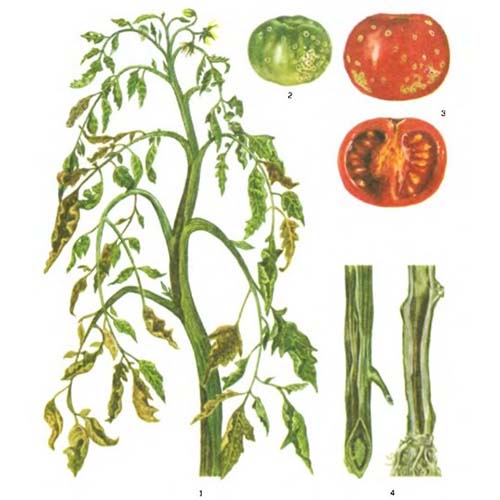
Is it always worth worrying if your tomatoes have curled leaves?
Thus, as you have understood, there is not always a reason to worry. This is often not a major problem. If the leaves are simply curled, while there are no spots, pests or other characteristic changes on them, then everything is in order. It is quite normal behavior (reaction) of the plant to not ideal growing conditions, which should not greatly affect its yield, of course, if you adjust your tomato care.
Popular opinion: «I always curl, but not all varieties. I do not see any problem in this, tk. the harvest is good, but I don't eat leaves :)»
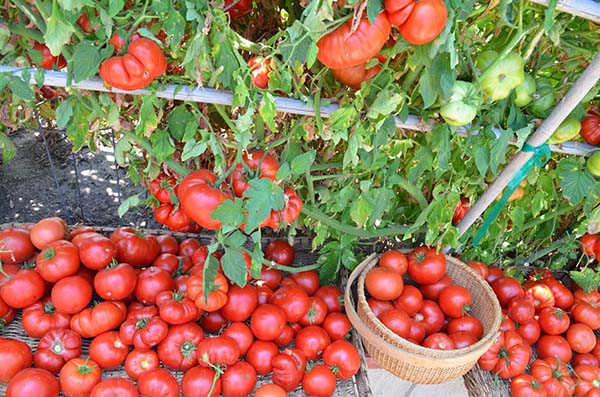
We hope that after reading this material, you will be able to figure out the reasons why the leaves of your tomatoes are curled and take appropriate measures. Health to you and your tomatoes!
Video: what to do if the leaves of tomatoes curl


Thank you for the article. I learned a lot of useful and useful things! I love tomatoes very much - I hope that I will get a good harvest.